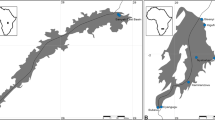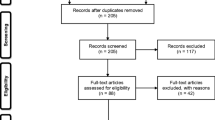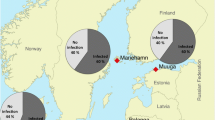Abstract
According to the enemy release hypothesis, one of the reasons for the successful establishment of non-indigenous species in a new habitat is the liberation from natural enemies, and among them the parasites. The rapid spread of the Red Sea/Indo-Pacific fish Fistularia commersonii in the Mediterranean Sea, which in just 7 years (2000–2007) invaded nearly all of the basin, gives an opportunity to study the dynamics of the host and its parasites in its recently invaded range. Information on the parasites of this fish in its original habitat is quite scarce. The present study describes the metazoan parasites of 40 specimens of F. commersonii (total length range 73–107 cm) caught in the Mediterranean Sea (Sardinia, Tunisia, Libya) from 2005 to 2015. The parasite fauna of this migrant in the recently invaded range is mainly a combination of generalist juvenile/larval species (probably acquired in the new habitat) with some of its adult natural parasites (probably co-introduced during migration). The results indicate that a non-indigenous species is not always released from its natural parasites and that its success is not simply associated with such liberation. Actually, the parasite fauna of F. commersonii increased along its migration path, acquiring new generalist species, but also conserving a subset of natural parasites. These data suggest caution in the uncritical acceptance of the enemy release hypothesis, because the different phases of the invasion process and establishment of a non-indigenous species appear to be related to a combination of ecological, physiological and behavioural factors.



Similar content being viewed by others
References
Abdel-Ghaffar F, Ali MA, Al Quraishy S, Al Rasheid K, Al Farraj S, Abdel-Baki AS, Bashtar AR (2008) Four new species of Ceratomyxa Thelohan 1892 (Myxozoa: Myxosporea: Ceratomyxidae) infecting the gallbladder of some Red Sea fishes. Parasitol Res 103(3):559–565
Anderson RM, May RM (1978) Regulation of host-parasite population interactions: I. Regulatory processes. J Anim Ecol 47(1):219–247
Anderson TJ, Nichol SL, Syms C, Przeslawski R, Harris PT (2011) Deep-sea bio-physical variables as surrogates for biological assemblages, an example from the Lord Howe Rise. Deep Sea Res Part II: Top Stud Oceanogr 58(7):979–991
Arndt E, Schembri PJ (2015) Common traits associated with establishment and spread of Lessepsian fishes in the Mediterranean Sea. Mar Biol 162(10):2141–2153
Aznar FJ, Hernández-Orts J, Suárez AA, García-Varela M, Raga JA, Cappozzo HL (2012) Assessing host-parasite specificity through coprological analysis: a case study with species of Corynosoma (Acanthocephala: Polymorphidae) from marine mammals. J Helminthol 86(2):156–164
Azzurro E, Pizzicori P, Andaloro F (2004) First record of Fistularia commersonii from the central Mediterranean. Cybium 28(1):72–74
Azzurro E, Soto S, Garofalo G, Maynou F (2013) Fistularia commersonii in the Mediterranean Sea: invasion history and distribution modeling based on presence-only records. Biol Invasions 15(5):977–990
Bariche M, Kajajian A, Azzurro E (2013) Reproduction of the invasive bluespotted cornetfish Fistularia commersonii (Teleostei, Fistulariidae) in the Mediterranean Sea. Mar Biol Res 9(2):169–180
Ben-Souissi J, Zaouali J, Bradai MN, Quignard JP (2004) Lessepsian migrant fishes off the coasts of Tunisia. First record of Fistularia commersonii (Osteichthyes, Fistularidae) and Parexocoetus mento (Osteichthyes, Exocoetidae). Vie et Milieu 54(4):247–248
Berland B (1984) Basic techniques involved in helminth preservation. Syst Parasitol 6(4):242–245
Bernardi G, Golani D, Azzurro E (2010) The genetics of Lessepsian bioinvasions. In: Golani D, Appelbaum-Golani B (eds) Fish invasions of the Mediterranean Sea: change and renewal. Pensoft Publishers, Sofia and Moscow, pp 71–84
Beveridge I, Bray RA, Cribb TH, Justine JL (2014) Diversity of trypanorhynch metacestodes in teleost fishes from coral reefs off eastern Australia and New Caledonia. Parasite 21(60):1–19
Bilecenoglu M, Taskavak E, Kunt KB (2002) Range extension of three Lessepsian migrant fish (Fistularia commersonii, Sphyraena flavicauda, Lagocephalus suezensis) in the Mediterranean Sea. J Mar Biol Assoc UK 82(3):525–526
Bray RA (2005) Family Lepocreadiidae Odhner, 1905. In: Jones A, Bray RA, Gibson DI (eds) Keys to the Trematoda, vol 2. CABI Publishing and the Natural History Museum, Wallingford, pp 545–602
Bush AO, Lafferty KD, Lotz JM, Shostak AW (1997) Parasitology meets ecology on its own terms: Margolis et al. revisited. J Parasitol 83(4):575–583
CIESM (2009) CIESM Atlas of exotic species in the Mediterranean Sea. http://www.ciesm.org/online/atlas/index.htm. Accessed 10 Nov 2015
Clarke KR (1993) Non-parametric multivariate analyses of changes in community structure. Aust J Ecol 18(1):117–143
Colautti R, Ricciardi A, Grigorovitch IA (2004) Is invasion success explained by the enemy release hypothesis? Ecol Lett 7(8):721–733
Corsini M, Kondilatos G, Economidis PS (2002) Lessepsian migrant Fistularia commersonii from the Rhodes marine area. J Fish Biol 61(4):1061–1062
Cribb TH (2005) Digenea (endoparasitic flukes). In: Rohde K (ed) Marine parasitology. CABI Publishing, Wallingford, pp 76–87
DAISIE (2008) European invasive alien species gateway. http://www.europe-aliens.org. Accessed 10 Nov 2015
Darwin C (1859) The origin of species. John Murray, London
Deidun A, Germanà A (2011) On the increasing occurrence of the bluespotted cornetfish Fistularia commersonii (Rüppel, 1838) in the central Mediterranean (Osteichthyes, Fistulariidae). Biodivers J 2(1):19–26
Diamant A (1989) Lessepsian migrant as hosts: a parasitological assessment of rabbitfish Siganus luridus and Siganus rivulatus (Siganidae) in their original and new biogeographical regions. In: Spanier E, Steinberger Y, Luria M (eds) Environmental quality and ecosystem stability: Vol IV-B, environmental quality. ISEEQS Publication, Jerusalem, pp 187–194
Diamant A (1998) Parasitological aspects in Red-Med fish migration. Actes du Colloque scientifique OCEANOS, Montpellier (France), April 11–12, 1996, pp 175–178
Dulčić J, Antolović N, Kožul V, Dragičević B, Lipej L (2013) First records of juveniles of two Lessepsian migrants, Fistularia commersonii Rüppell, 1838 and Siganus luridus (Rüppell, 1829), in the Adriatic Sea. J Appl Ichthyol 29(3):661–662
Elton CS (1958) The ecology of invasion by animals and plants. Methuen, London
Fernández J, Villalba C (1986) Contribución al conocimiento del género Caligus Müller, 1785 (Copepoda: Siphonostomatoida) en Chile. Gayana Zool 50(1–4):37–62
Fischthal JH (1980) Some digenetic trematodes of marine fishes from Israel’s Mediterranean coast and their zoogeography, especially those from Red Sea immigrant fishes. Zool Scr 9(1–4):11–23
Fritzsche RA (1976) A review of the cornetfishes, genus Fistularia (Fistularidae), with a discussion of intrageneric relationship and zoogeography. Bull Mar Sci 26(2):196–204
Froese T, Pauly D (eds) (2011) Fishbase, world wide web electronic publication. http://www.fishbase.org. Accessed 10 Nov 2015
Galil BS (2007) Loss or gain? Invasive aliens and biodiversity in the Mediterranean Sea. Mar Pollut Bull 55(7):314–322
Garibaldi F, Orsi Relini L (2008) Record of the bluespotted cornetfish Fistularia commersonii Rüppell, 1838 in the Ligurian Sea (NW Mediterranean). Aquat Invasions 3(4):471–474
Gendron AD, Marcogliese DJ, Thomas M (2012) Invasive species are less parasitized than native competitors, but for how long? The case of the round goby in the Great Lakes-St. Lawrence Basin. Biol Invasions 14(2):367–384
Golani D (1998) Distribution of Lessepsian migrant fish in the Mediterranean. Ital J Zool 65(1):95–99
Golani D (2000) First record of the bluespotted cornetfish from the Mediterranean Sea. J Fish Biol 56(6):1545–1547
Golani D, Appelbaum-Golani B (eds) (2010) Fish invasions of the Mediterranean Sea: change and renewal. Pensoft, Sofia-Moscow
Golani D, Azzurro E, Corsini-Foka M, Falautano M, Andaloro F, Bernardi G (2007) Genetic bottlenecks and successful biological invasions: the case of a recent Lessepsian migrant. Biol Lett 3(5):541–545
Hänfling B (2007) Understanding the establishment success of non-indigenous fishes: lessons from population genetics. J Fish Biol 71(Suppl D):115–135
Hayward C (2005) Monogenea Polyopisthocotylea (ectoparasitic flukes). In: Rohde K (ed) Marine parasitology. CABI Publishing, Wallingford, pp 55–63
Ho J-S, Cheng S-H, Chang W-C, Lin C-L (2008) Two species of siphonostomatoid copepods parasitic on marine fishes of Taiwan. J Fish Soc Taiwan 35(1):87–99
Hoberg EP (2005) Coevolution in marine systems. In: Rohde K (ed) Marine parasitology. CABI Publishing, Wallingford, pp 327–339
Jackson AM, Tenggardjaja K, Perez G, Azzurro E, Golani D, Bernardi G (2015) Phylogeography of the bluespotted cornetfish, Fistularia commersonii: a predictor of bioinvasion success? Mar Ecol 36(4):887–896
Kara MH, Oudjane F (2008) First observations of the Indo-Pacific bluespotted cornetfish Fistularia commersonii (Fistulariidae) from Algerian coasts. Mar Biodivers Rec 2:e83
Karachle PK, Triantaphyllidis C, Stergiou KI (2004) Bluespotted cornetfish, Fistularia commersonii Rüppell, 1838: a Lessepsian sprinter. Acta Icht Piscat 34(1):103–108
Keane RM, Crawley MJ (2002) Exotic plant invasions and the enemy release hypothesis. Trends Ecol Evol 17(4):164–170
Kennedy MJ (1979) Basic methods of specimen preparation in parasitology. International Development Research Centre, Ottawa
Kvach Y, Skóra KE (2007) Metazoa parasites of the invasive round goby Apollonia melanostoma (Neogobius melanostomus) (Pallas) (Gobiidae: Osteichthyes) in the Gulf of Gdańsk, Baltic Sea, Poland: a comparison with the Black Sea. Parasitol Res 100(4):767–774
Lacerda AC, Takemoto RM, Poulin R, Pavanelli GC (2013) Parasites of the fish Cichla piquiti (Cichlidae) in native and invaded Brazilian basins: release not from the enemy, but from its effects. Parasitol Res 112(1):279–288
Lom J (2005) Myxozoa (myxozoans). In: Rohde K (ed) Marine parasitology. CABI Publishing, Wallingford, pp 41–46
MacColl AD, Chapman SM (2010) Parasites can cause selection against migrants following dispersal between environments. Funct Ecol 24(4):847–856
MacKenzie K, Abaunza P (2014) Parasites as biological tags. In: Cadrin SX, Kerr LA, Mariani S (eds) Stock identification methods, Applications in Fisheries Science, 2nd edn. Elsevier Academic Press, New York, pp 185–203
May RM, Anderson RM (1978) Regulation and stability of host-parasite population interactions: II. Destabilizing processes. J Anim Ecol 47(1):249–267
Mele S, Pennino MG, Piras MC, Bellido JM, Garippa G, Merella P (2014) Parasite of the head of Scomber colias (Osteichthyes: Scombridae) from the western Mediterranean Sea. Acta Parasitol 59(1):173–183
Merella P, Farjallah S, Pais A, Follesa MC, Garippa G (2007) Fistularia commersonii Rüppell, 1835: a Lessepsian host carrier of Indo-Pacific parasites into the Mediterranean Sea. VII International Symposium on Fish Parasites, Viterbo (Italy), September 24–28 2007. Parassitologia 49(Suppl. 2):249
Merella P, Pais A, Follesa MC, Farjallah S, Gagliardi F, Mele S, Piras MC, Garippa G (2015) Parasites of the Lessepsian sprinter Fistularia commersonii (Osteichthyes: Fistulariidae): an update after 15 years since its arrival in the Mediterranean Sea. IX International Symposium on Fish Parasites, Valencia (Spain), August 31 2015–September 05 2015, p 87
Møller AP (2005) Parasitism and the regulation of host populations. In: Thomas F, Renaud F, Guégan J-F (eds) Parasitism and ecosystems. Oxford University Press, Oxford, pp 43–53
Moon SY, Kim IH (2012) Sea lice (Copepoda, Siphonostomatoida, Caligidae) new to Korea, including three new species. J Species Res 1(2):175–217
Moravec F, Justine JL (2010) Some trichinelloid nematodes from marine fishes off New Caledonia, including description of Pseudocapillaria novaecaledoniensis sp. nov. (Capillariidae). Acta Parasitol 55(1):71–80
Nahhas FM, Nasser H, Tam J (2004) Digenetic trematodes of marine fishes from Suva, Fiji: families: Acanthocolpidae, Lepocreadiidae, Bivesiculidae, Zoogonidae, Monorchiidae and description of a new species. Riv Parassitol 21(1):33–48
Oksanen J (2015) Multivariate analysis of ecological communities in R: Vegan tutorial. https://cran.r-project.org/web/packages/vegan/vegan.pdf. Accessed 04 Dec 2015
Paggi L, Orecchia P, Della Seta G (1975) A new Acanthocephala Breizacanthus ligur sp. n. (Palaeacanthocephala: Arhythmacanthidae Yamaguti, 1935) parasite of some species of benthic fishes from the Ligurian Sea. Parassitologia 17(1–3):83–94
Pais A, Merella P, Follesa MC, Garippa G (2007) Westward range expansion of the Lessepsian migrant Fistularia commersonii (Fistulariidae) in the Mediterranean Sea, with notes on its parasites. J Fish Biol 70(1):269–277
Pérez-Ponce de León G, León-Règagnon V, Monks S (1998) Theletrum lamothei sp. nov. (Digenea), parasite of Echidna nocturna from Cuajiniquil, Guanacaste, and other digenes of marine fishes from Costa Rica. Rev Biol Trop 46(2):345–354
Por FD (1971) One hundred years of Suez Canal: a century of Lessepsian migration: retrospect and viewpoints. Syst Zool 20(2):138–159
Por FD (1978) Lessepsian migration. The influx of Red Sea biota into the Mediterranean by way of the Suez Canal. Ecological Studies 23. Springer, Berlin
Poulin R, Mouillot D (2003) Host introductions and the geography of parasite taxonomic diversity. J Biogeogr 30:837–845
Quignard JP, Tomasini JA (2000) Mediterranean fish biodiversity. Biol Mar Medit 7(3):1–66
R Development Core Team (2015) R: a language and environment for statistical computing. R Foundation for Statistical Computing, Vienna, Austria. http://www.R-project.org
Reiczigel J, Rózsa L, Reiczigel A (2013) Quantitative Parasitology (QPweb). http://www2.univet.hu/qpweb
Rigby MC, Lo CM, Cribb TH, Euzet L, Faliex E, Galzin R, Holmes JC, Morand S (1999) Checklist of the parasites of coral reef fishes from French Polynesia, with considerations on their potential role in these fish communities. Cybium 23(3):273–284
Roche DG, Leung B, Mendoza EF, Torchin ME (2010) Higher parasite richness, abundance and impact in native versus introduced cichlid fishes. Int J Parasitol 40(13):1525–1530
Sanchez-Tocino L, Hidalgo Puertas F, Pontes M (2007) First record of Fistularia commersonii Rüppell, 1838 (Osteichthyes: Fistulariidae) in Mediterranean waters of the Iberian Peninsula. Zool Baetica 18:79–84
Sanna D, Scarpa F, Lai T, Cossu P, Falautano M, Castriota L, Andaloro F, Follesa MC, Francalacci P, Curini-Galletti M, Casu M (2015) Fistularia commersonii (Teleostea: Fistulariidae): walking through the Lessepsian paradox of mitochondrial DNA. Ital J Zool 82(4):499–512
Santoro M, Badillo FJ, Mattiucci S, Nascetti G, Bentivegna F, Insacco G, Travaglini A, Paoletti M, Kinsella JM, Tomás J, Raga JA, Aznar FJ (2010) Helminth communities of loggerhead turtles (Caretta caretta) from Central and Western Mediterranean Sea: the importance of host’s ontogeny. Parasitol Int 59(3):367–375
Scharsack JP, Kalbe M, Harrod C, Rauch G (2007) Habitat-specific adaptation of immune responses of stickleback (Gasterosteus aculeatus) lake and river ecotypes. Proc R Soc B 274(1617):1523–1532
Streftaris N, Zenetos A (2006) Alien marine species in the Mediterranean: the 100 “worst invasives” and their impact. Medit Mar Sci 7(1):87–118
Taraschewski H (2005) Copepoda (copepods). In: Rohde K (ed) Marine parasitology. CABI Publishing, Wallingford, pp 123–138
Tillier J-B (1902) Le Canal de Suez et sa faune ichthyologique. Mém Soc Zool Fr 15(3):279–318
Torchin ME, Lafferty KD, Kuris AM (2002) Parasites and marine invasions. Parasitology 124:137–151
Vignon M, Sasal P (2010) Fish introduction and parasites in marine ecosystems: a need for information. Environ Biol Fish 87(1):1–8
Vignon M, Sasal P, Galzin R (2009) Host introduction and parasites: a case study on the parasite community of the peacock grouper Cephalopholis argus (Serranidae) in the Hawaiian Islands. Parasitol Res 104(4):775–782
Whittington D (2005) Monogenea Monopisthocotylea (ectoparasitic flukes). In: Rohde K (ed) Marine parasitology. CABI Publishing, Wallingford, pp 63–72
Zintzen V, Roberts CD, Clark MR, Williams A, Althaus F, Last PR (2011) Composition, distribution and regional affinities of the deepwater ichthyofauna of the Lord Howe Rise and Norfolk Ridge, south-west Pacific Ocean. Deep Sea Res Part II: Topical Stud Oceanogr 58(7):933–947
Acknowledgments
Many thanks to the sport/professional fishermen, the colleagues and friends, particularly F Gagliardi and all the Staff of the Aquarium of Cala Gonone, who collaborated and made available the specimens of Fistularia commersonii. A special thank to RA Bray, J Hernandez, JL Justine and HW Palm, for their help and advice. RA Bray revised the English of the manuscript. Comments and suggestions of two anonymous reviewers have improved the quality of the paper.
Author information
Authors and Affiliations
Corresponding author
Additional information
Responsible Editor: T. Reusch.
Reviewed by Undisclosed experts.
This article is part of the Topical Collection on Invasive Species.
Rights and permissions
About this article
Cite this article
Merella, P., Pais, A., Follesa, M.C. et al. Parasites and Lessepsian migration of Fistularia commersonii (Osteichthyes, Fistulariidae): shadows and light on the enemy release hypothesis. Mar Biol 163, 97 (2016). https://doi.org/10.1007/s00227-016-2865-3
Received:
Accepted:
Published:
DOI: https://doi.org/10.1007/s00227-016-2865-3




